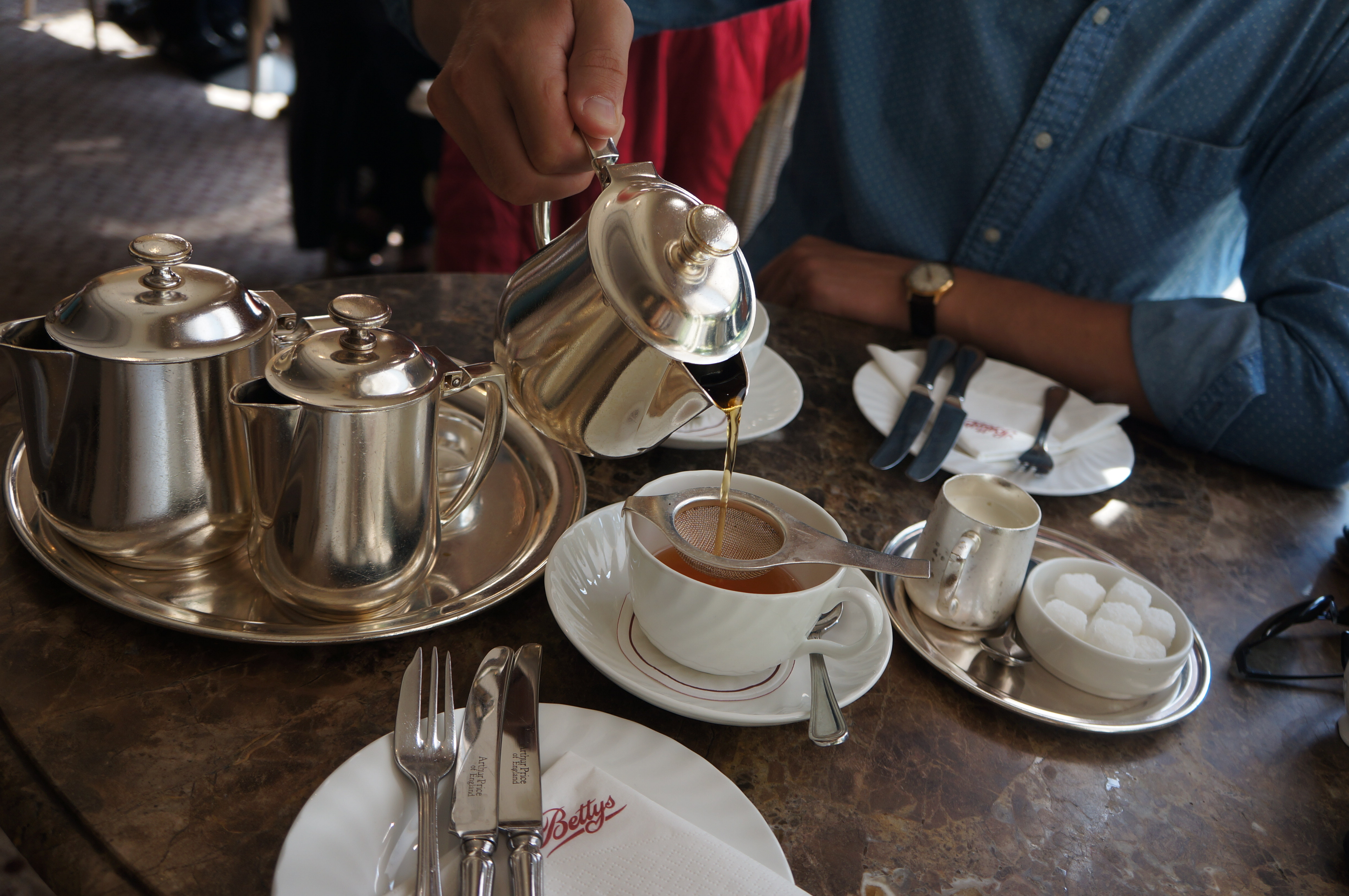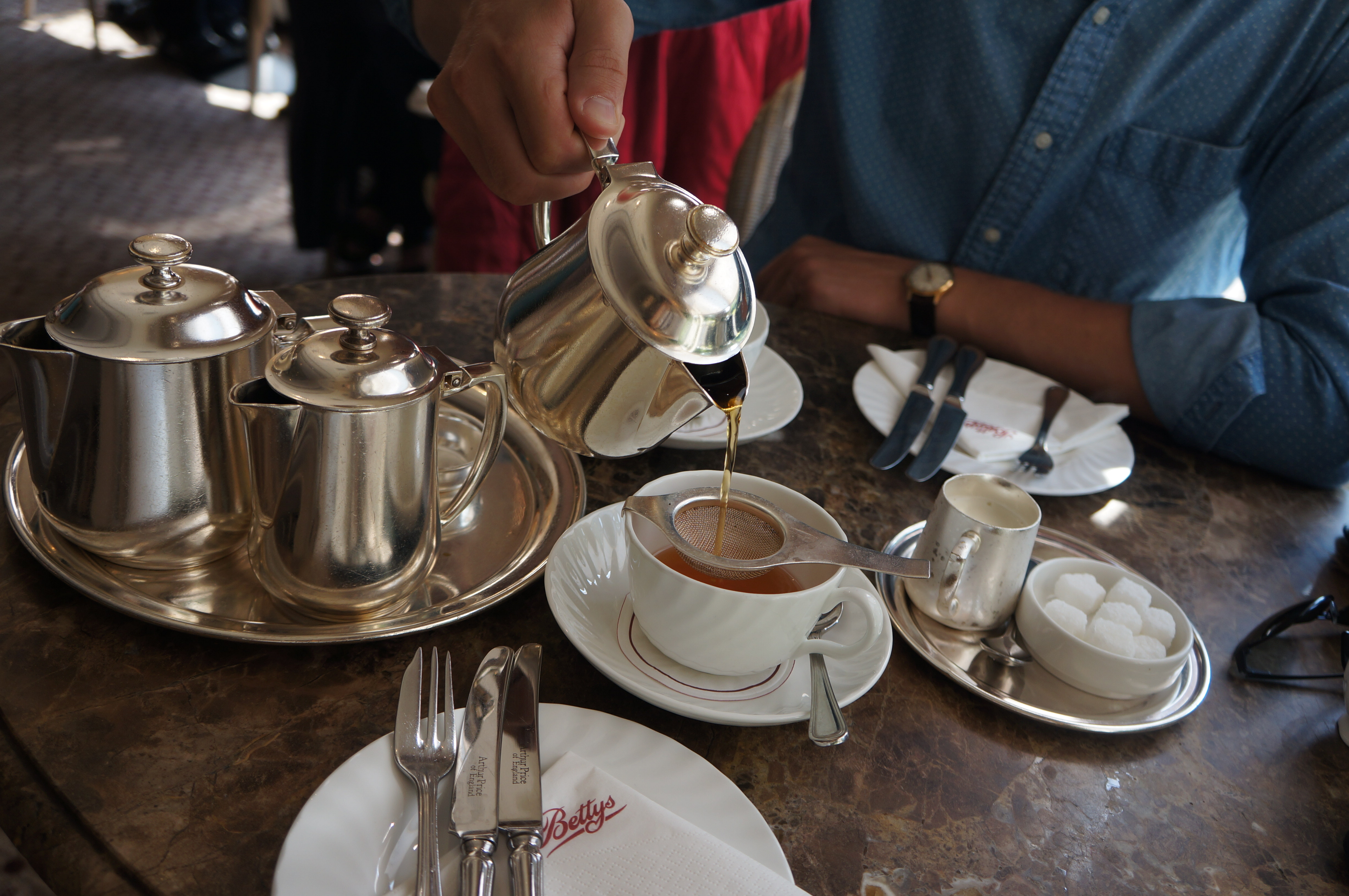大家應該都看過,甚至也許自己就擁有一個上面印著 “Keep calm and Carry On” (保持冷靜,繼續前進)字樣的馬克杯。會印上這些字樣其來有自,因為大多英國人相信喝上一杯茶,就能解決大部分的問題。不過,在英國超市裡賣的茶,即使包裝上寫著 Loose Tea(散茶),也並非完整葉片。

在英國女王伊莉莎白一世的統治期間(西元 1558 – 1603 年),英式茶變得越來越受歡迎。當時英國東印度公司會將茶葉自印度運往英國,當時茶的地位很崇高,只有上流社會才喝的到,中產及勞動階級的人民只能喝非法走私的茶過過乾癮。
不過,在這之前,英國人其實愛咖啡更勝茶。那時咖啡店分佈在首都倫敦的各角落,賣著咖啡、蛋糕及餅乾等餐點。是後來因珍貴的茶葉大量湧入,咖啡店才一個個轉改賣茶。
先倒茶?先倒奶?永遠沒有結論的熱門話題
我記得在我成長期間,不管跟家人還是朋友,茶都是社交場合中的重要角色。這麼說吧!咖啡適合早上喝,茶卻能接下來的任何時間享用。
典型的英國人喝茶時間表為:11:00 第一杯(假設你早餐喝的是咖啡),14:00 第二杯(下午茶時間!通常會搭配司康與果醬、水果麵包或餅乾),18:00 第三杯(通常邊看電視或書邊喝),而一天中的最後第四杯茶則是晚上 20:00 左右。

所以,平均來說,英國人一天喝 3 – 5 杯茶。不過泡茶的方式倒是各有不同,有的人習慣用茶包,靜置在熱水中兩三分鐘,再加牛奶及糖(加糖這件事基本上是被嘲笑的)。也有人認為泡茶是值得驕傲的放鬆時光,他們取一壺水,煮到快沸騰時再把一點點水倒入茶壺清洗。水煮沸後再把茶葉與水倒入洗過的溫熱茶壺,蓋上蓋子與保溫罩,靜置 3 – 5 分鐘即可,時間長取決於每個人對濃度的偏好。最後備受爭議的一步,就是看你要先倒牛奶到杯中,再倒茶,還是茶先於奶。

每個人加牛奶的順序都不同,常常成為備受爭論的話題。雖然我不覺得加的次序會影響味道,但我還是偏好先倒茶,再倒牛奶,因為我喜歡在攪拌時,看到牛奶在茶中旋轉的樣子。
所以,現在你總該知道英國人是怎麼準備茶的了!
想品茶?先去茶葉專賣店
後來我來到台灣,才發現一件我從來不知道的事:台灣人對茶的重視就跟英國人一樣!在台灣任何角落,都能找到茶葉專賣店,他們不僅賣台灣本土的茶,也供應進口自中國、日本及印度等地的茶。而隨處可見的便利商店,只要不到新台幣 25 元就能買到紅茶、烏龍茶、綠茶或奶茶。
在我學中文期間,我盡可能跟不諳英語的台灣人說中文,為什麼?因為如果有不懂的地方,我能從他們口中聽到中文解釋,進而迫使自己學習,而不是依靠會說英文的人翻譯給我聽。所以我常常往茶葉專賣店跑,不僅因為我愛茶,也因我喜歡泡茶的方式和茶在台灣人心中的地位。而且,在店裡和大家聊天真的一點也不奇怪,反而充分感受到台灣人的友善!就這樣,我去過無數間茶葉專賣店,我在那品嘗各種茶、和大家討論台灣茶、英國茶和印度茶的異同,感受啜飲與交談之間的恬淡氛圍。我還買了一組茶具,週末在家看電視放鬆的時候就會泡上幾回。雖然喝過許多品種的茶,但要從中選出最愛卻不容易。我喜歡的有梨山的高山烏龍茶、文山區的鐵觀音,還有中國福建充滿絕妙茉莉花香氣的香片。

台灣賣的茶葉種類與品質絕對足以與其它世界級茶葉相比,但畢竟每個人的口味都是主觀的,所以重點並不是選出最棒的茶。雖說如此,但也難以忽略台灣擁有豐富茶品的事實。如果你在台灣,而且還沒開始你的品茶旅程,不妨找一間茶葉專賣店,和店裡的人交流。如果你要來台灣玩,記得去文山區的貓空,在那裡,你可以邊品茶,邊眺望台北市的美麗日落。不過,千萬別來了台灣又忽略茶的美好,錯過了它的特別真的很可惜!
翻譯: Ting Wei
編輯:Jean Kuo
Industry Advisor:Rachel An
圖:booksnooksandtea/tea-tography/potatomato/5ftinf/Ash
No doubt you have seen (and more than likely own) one of those mugs that has written on it in bold print: “Keep calm, and carry on”. Well, there is a reason it is on a mug: English people believe that almost anything can be solved with a cup of tea. However, in England, even though on the tea boxes at the supermarket is may say “loose tea”, it isn’t whole leaf, like many Taiwanese sold teas.

English tea really became popular and highly valued in the rule of Queen Elizabeth 1st reign, which ended in early 1600. Tea was imported from India through the British East India Company like nothing else that had been imported before. English people held tea in such high esteem that it was only really available to the higher class, with both the middle and lower class having to be content with purchasing illegally smuggled tea.
In fact, one thing that a lot of people do not realise, is that the English used to really enjoy coffee before the days of tea. In the early days, cafes were scattered throughout the capital selling coffee, cakes, cookies etc. But, with the influx of imported tea and the fact that it was such a highly valued commodity, this later turned the cafes from coffee sellers, to tea sellers.
I remember when I was growing up, that tea played a huge social role between households and friends. Coffee is for the morning, but tea is for the rest of the day.
A typical tea drinking schedule: 11:00 1st cup of the day (providing you had coffee, not tea, for breakfast), 14:00 2nd cup of the day (perfect afternoon tea time, often accompanied by a scone with jam, a slice of fruit loaf or some biscuits – known as cookies to most Americans), 18:00 3rd cup of the day (often had whilst watching some TV or relaxing with a book) and the final 4th cup of the day had at around 20:00.

I guess you could say, that on average, English people drink 3-5 cups of tea per day. For some people, tea making is as simple as putting a tea bag in a mug, leaving it for 2-3mins, adding some milk and adding some sugar (although the addition of sugar is often scoffed at). But, for other people, tea making is a relaxing time and something done with pride. For those people, the process is as follows: boil a kettle and use the water just before it boils to rinse the teapot, let the kettle finish the boil whilst adding loose tea to the hot rinsed tea pot, put the lid on the teapot and stick a tea cosy on top to keep it warm whilst brewing for 3-5mins (depending on preferred strength), after such a time there is a real sticking point with the next step: add the milk to the mug first OR pour the tea into your mug and then add the milk.

Milk adding is often a disputed subject in households with many people choosing differently. Personally, whilst I do not think it affects flavour much at all, I choose to add the milk after pouring the tea because I like to see the milk swirl in the mug when I stir it…
And, there you have it. You now know how to pour tea like the English do!
But, what I didn’t realise at all on first arriving in Taiwan, is quite how much tea is held in high regard here, too! You can walk in any city, in any county, throughout Taiwan and find specialist tea shops who import tea from a variety of local and foreign locations around Taiwan, China, Japan, India etc. You can walk into any convenience store and buy black (red, here) tea, Oolong tea, green tea or milk tea for less than $25TWD.
Whilst studying Chinese, I tried to take every opportunity to speak with local Taiwanese people who couldn’t speak English. Why? Because, if I don’t understand the mandarin that’s being spoken to me, then I don’t want it explained in English. I want it explained in Chinese, forcing me to learn. So, for me, I spent a lot of time in tea shops. I have a love for tea, the ceremony and the social aspect of it, too. And, it really is just ok to sit with customers and drink tea inside these tea selling shops. The Taiwanese really are a friendly bunch! I have sat for countless numbers of hours in tea shops all over Taiwan, soaking in the atmosphere, drinking tea, talking about similarities between English tea, Indian tea, Taiwanese tea etc and trying all of the different grades and types of tea I could get my hands on. Not only do I enjoy doing it for this social reason, but it led me to buy a tea set of my own for my home, brewing regularly whilst watching TV or relaxing at the weekend. I would say that my favourite tea to date is too difficult to pin down, but a couple of my favourites have been a high mountain oolong from LiShan (Pear mountain) in TaiChung, TieGuanYin ‘Iron buddha’ tea from the WenShan area of Taipei, and the incredibly special Green tea with the Jasmine flour inside that opens up when brewed from FuJian province, China.

The tea available in Taiwan is enough to rival any other world class tea out there, but it’s not about who has the ‘best’ tea, because that’s totally subjective. With that being said, I think it is difficult to overlook what Taiwan has to offer with regards to tea. If you are living in Taiwan and haven’t done it yet, then go and sit in a tea shop and relax with the local Taiwanese. If you’re visiting, then go and visit the MaoKong area in the WenShan District of Taipei and sit enjoying your favourite brew with a view of Taipei City whilst watching the sunset. But, please, don’t come here and ignore the tea, it really is quite special!








